Responses of Pre-Holed Granite under Coupled Biaxial Loading and Unloading Stress Condition
Abstract
:1. Introduction
2. Methodology
2.1. Numerical Model
2.2. Pre-Holed Specimens
2.3. Loading Paths
3. Results and Discussion
3.1. Peak Stresses at Rock Failure
3.2. Cracking Development
3.3. Failure Properties
4. Conclusions
Author Contributions
Funding
Conflicts of Interest
References
- Patel, S.; Martin, C.D. Effect of Stress Path on the Failure Envelope of Intact Crystalline Rock at Low Confining Stress. Minerals 2020, 10, 1119. [Google Scholar] [CrossRef]
- Nguyen, T.S. Progressive Damage of a Canadian Granite in Laboratory Compression Tests and Underground Excavations. Minerals 2021, 11, 10. [Google Scholar] [CrossRef]
- Park, C.H.; Bobet, A. Crack coalescence in specimens with open and closed flaws: A comparison. Int. J. Rock Mech. Min. Sci. 2009, 46, 819–829. [Google Scholar] [CrossRef]
- Wang, S.Y.; Sloan, S.W.; Sheng, D.C.; Tang, C.A. 3D numerical analysis of crack propagation of heterogeneous notched rock under uniaxial tension. Tectonophysics 2016, 677–678, 45–67. [Google Scholar] [CrossRef]
- Wang, S.; Tang, Y.; Wang, S. Influence of brittleness and confining stress on rock cuttability based on rock indentation tests. J. Cent. South Univ. 2021, 28, 2786–2800. [Google Scholar] [CrossRef]
- Wang, S.; Tang, Y.; Li, X.; Du, K. Analyses and predictions of rock cuttabilities under different confining stresses and rock properties based on rock indentation tests by conical pick. Trans. Nonferrous Met. Soc. China 2021, 31, 1766–1783. [Google Scholar] [CrossRef]
- Huang, D.; Gu, D.; Yang, C.; Huang, R.; Fu, G. Investigation on Mechanical Behaviors of Sandstone with Two Preexisting Flaws under Triaxial Compression. Rock Mech. Rock Eng. 2016, 49, 375–399. [Google Scholar] [CrossRef]
- Yang, H.-Q.; Liu, J.-F.; Zhou, X.-P. Effects of the Loading and Unloading Conditions on the Stress Relaxation Behavior of Pre-cracked Granite. Rock Mech. Rock Eng. 2017, 50, 1157–1169. [Google Scholar] [CrossRef]
- Feng, X.-T.; Ding, W.; Zhang, D. Multi-crack interaction in limestone subject to stress and flow of chemical solutions. Int. J. Rock Mech. Min. Sci. 2008, 46, 159–171. [Google Scholar] [CrossRef]
- Yang, S.-Q.; Jing, H.-W. Strength failure and crack coalescence behavior of brittle sandstone samples containing a single fissure under uniaxial compression. Int. J. Fract. 2011, 168, 227–250. [Google Scholar] [CrossRef]
- Huang, Y.-H.; Yang, S.-Q.; Ranjith, P.; Zhao, J. Strength failure behavior and crack evolution mechanism of granite containing pre-existing non-coplanar holes: Experimental study and particle flow modeling. Comput. Geotech. 2017, 88, 182–198. [Google Scholar] [CrossRef]
- Zeng, W.; Yang, S.-Q.; Tian, W.-L. Experimental and numerical investigation of brittle sandstone specimens containing different shapes of holes under uniaxial compression. Eng. Fract. Mech. 2018, 200, 430–450. [Google Scholar] [CrossRef]
- Yang, S.-Q.; Huang, Y.-H.; Tian, W.-L.; Zhu, J. An experimental investigation on strength, deformation and crack evolution behavior of sandstone containing two oval flaws under uniaxial compression. Eng. Geol. 2017, 217, 35–48. [Google Scholar] [CrossRef]
- Bahaaddini, M.; Sharrock, G.; Hebblewhite, B.K. Numerical investigation of the effect of joint geometrical parameters on the mechanical properties of a non-persistent jointed rock mass under uniaxial compression. Comput. Geotech. 2013, 49, 206–225. [Google Scholar] [CrossRef]
- Zhao, Z.-H.; Zhou, D. Mechanical properties and failure modes of rock samples with grout-infilled flaws: A particle mechanics modeling. J. Nat. Gas Sci. Eng. 2016, 34, 702–715. [Google Scholar] [CrossRef]
- Yoon, J. Application of experimental design and optimization to PFC model calibration in uniaxial compression simulation. Int. J. Rock Mech. Min. Sci. 2007, 44, 871–889. [Google Scholar] [CrossRef]
- Areias, P.; Dias-da-Costa, D.; Alfaiate, J.; Júlio, E. Arbitrary bi-dimensional finite strain cohesive crack propagation. Comput. Mech. 2009, 45, 61–75. [Google Scholar] [CrossRef]
- Cao, R.-H.; Cao, P.; Fan, X.; Xiong, X.; Lin, H. An Experimental and Numerical Study on Mechanical Behavior of Ubiquitous-Joint Brittle Rock-Like Specimens Under Uniaxial Compression. Rock Mech. Rock Eng. 2016, 49, 4319–4338. [Google Scholar] [CrossRef]
- Chen, M.; Yang, S.-Q.; Ranjith, P.G.; Zhang, Y.-C. Cracking behavior of rock containing non-persistent joints with various joints inclinations. Theor. Appl. Fract. Mech. 2020, 109, 102701. [Google Scholar] [CrossRef]
- Ding, X.; Zhang, L. A new contact model to improve the simulated ratio of unconfined compressive strength to tensile strength in bonded particle models. Int. J. Rock Mech. Min. Sci. 2014, 69, 111–119. [Google Scholar] [CrossRef]
- Fan, X.; Li, K.; Lai, H.; Xie, Y.; Cao, R.; Zheng, J. Internal stress distribution and cracking around flaws and openings of rock block under uniaxial compression: A particle mechanics approach. Comput. Geotech. 2018, 102, 28–38. [Google Scholar] [CrossRef]
- Chen, Z.-H.; Li, X.-B.; Weng, L.; Wang, S.; Dong, L. Influence of Flaw Inclination Angle on Unloading Responses of Brittle Rock in Deep Underground. Geofluids 2019, 4657645. [Google Scholar] [CrossRef] [Green Version]
- Yang, S.-Q.; Huang, Y.-H. Failure behaviour of rock-like materials containing two pre-existing unparallel flaws: An insight from particle flow modeling. Eur. J. Environ. Civ. Eng. 2018, 22 (Suppl. 1), 57–78. [Google Scholar] [CrossRef]
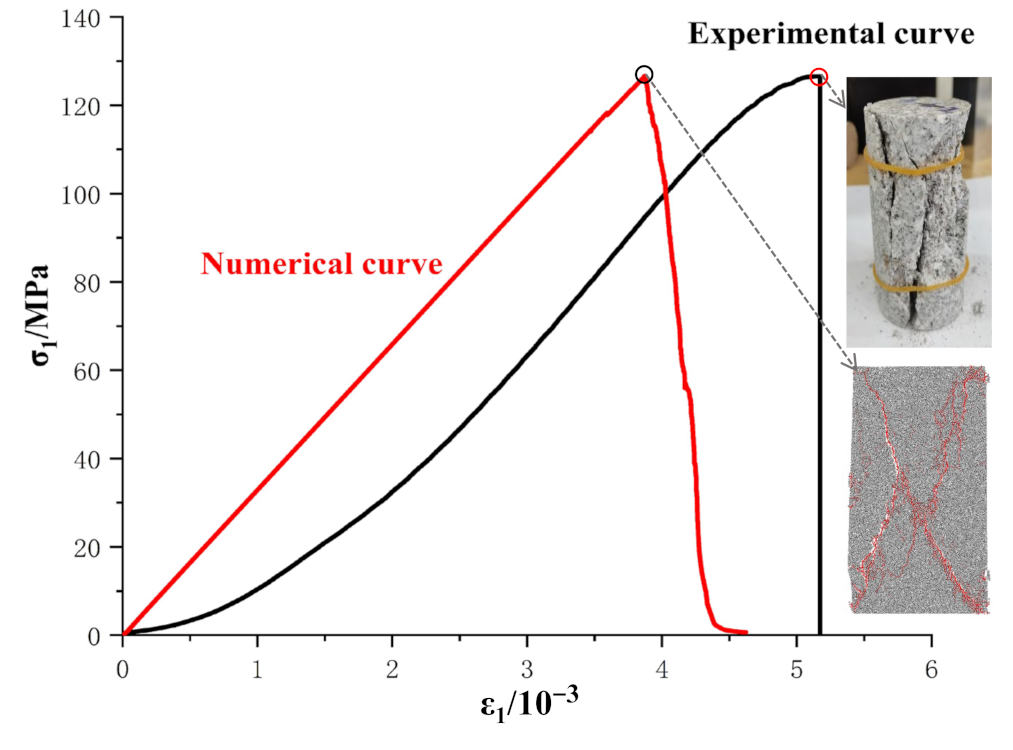

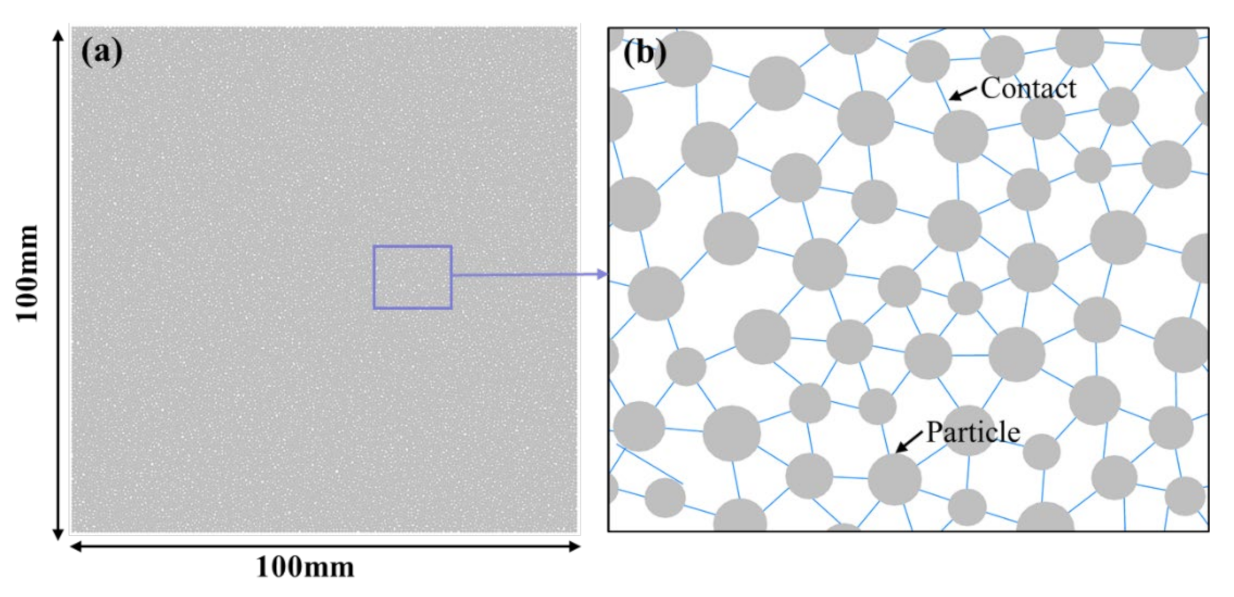
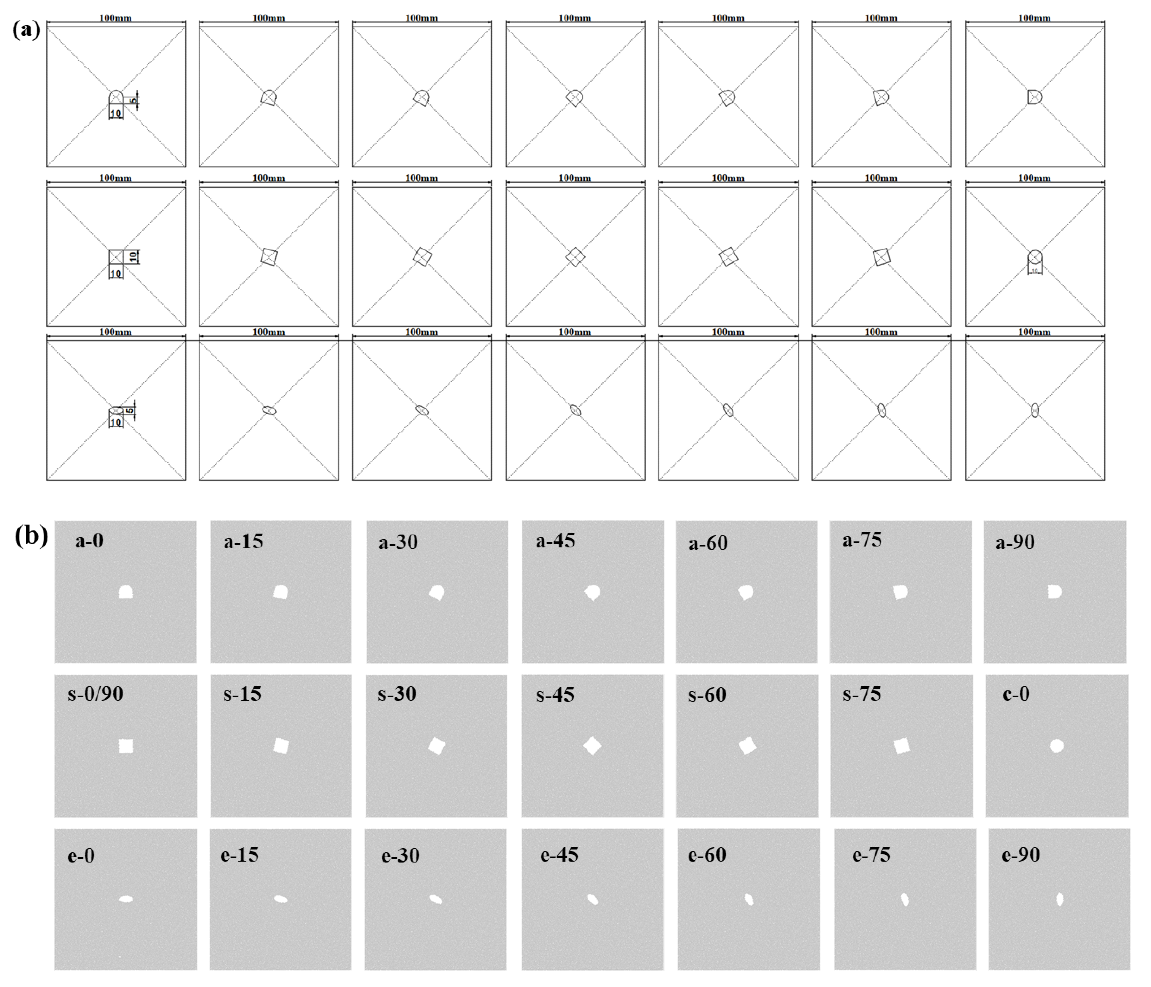


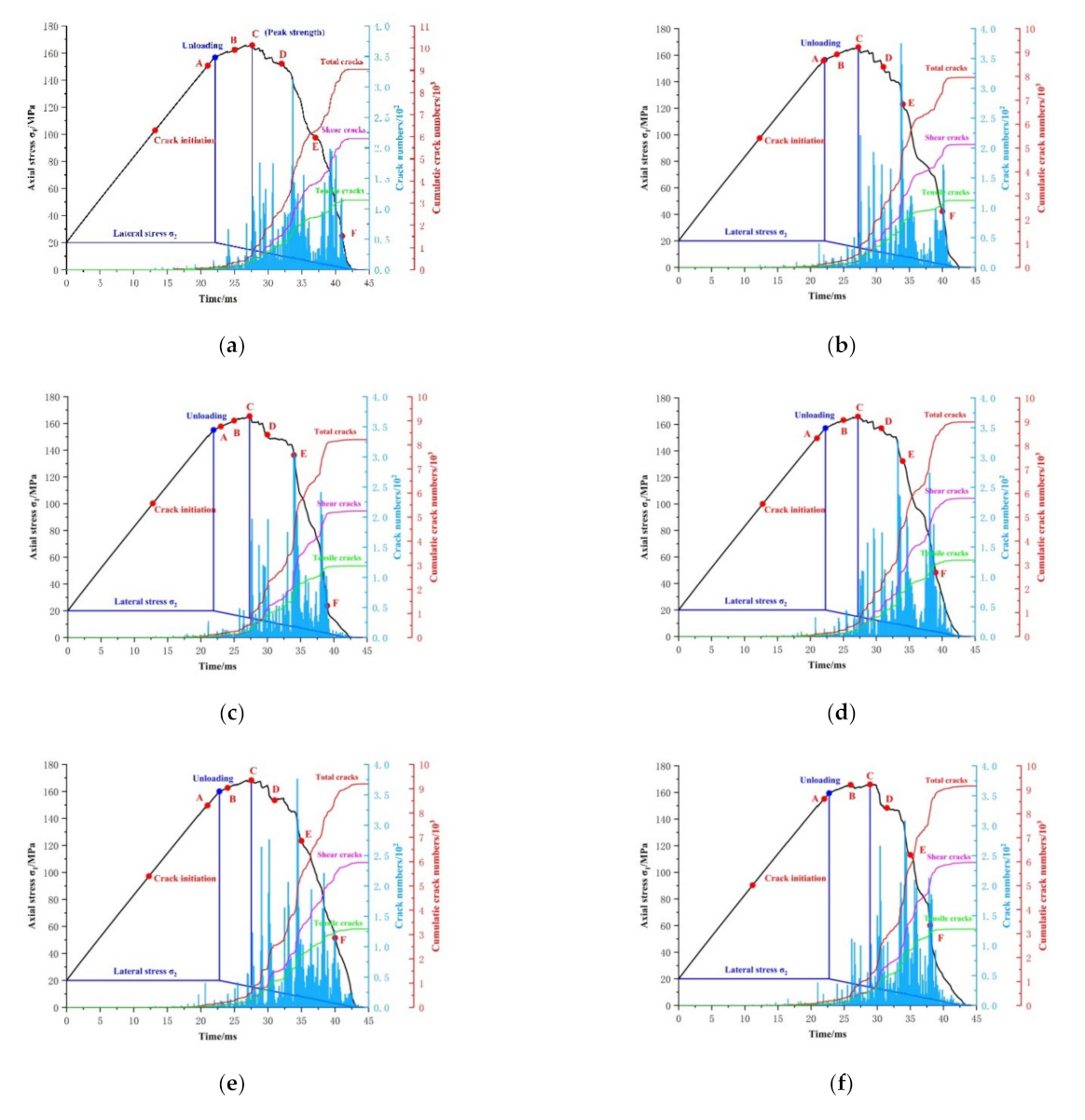
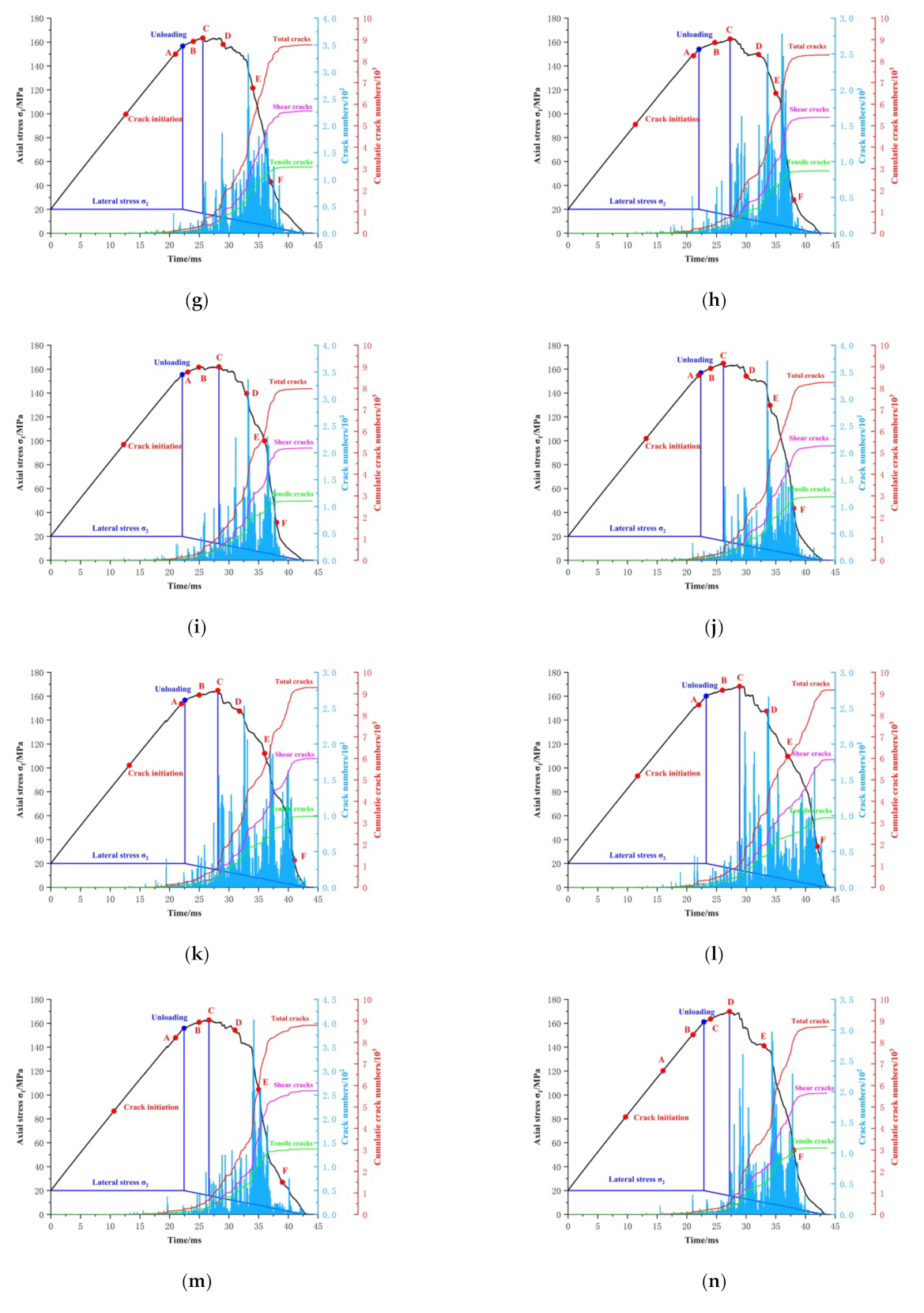

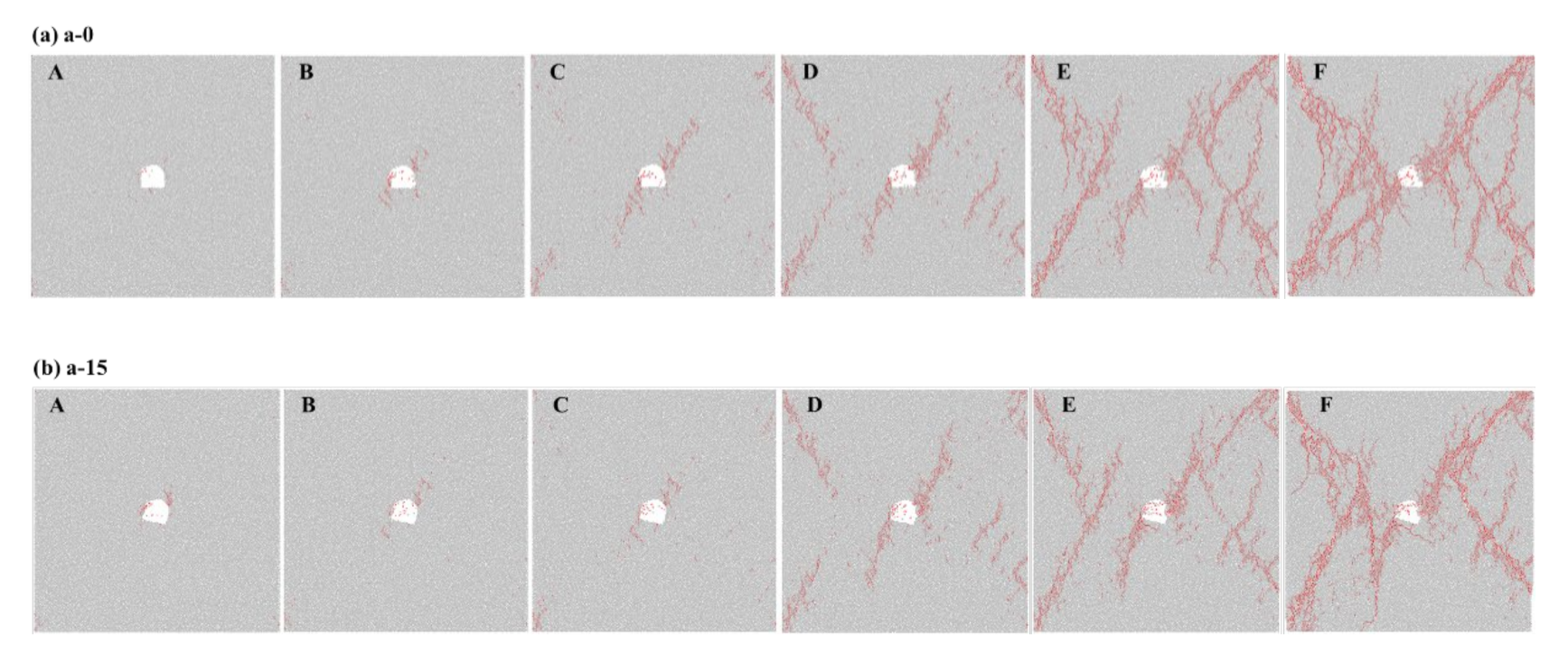
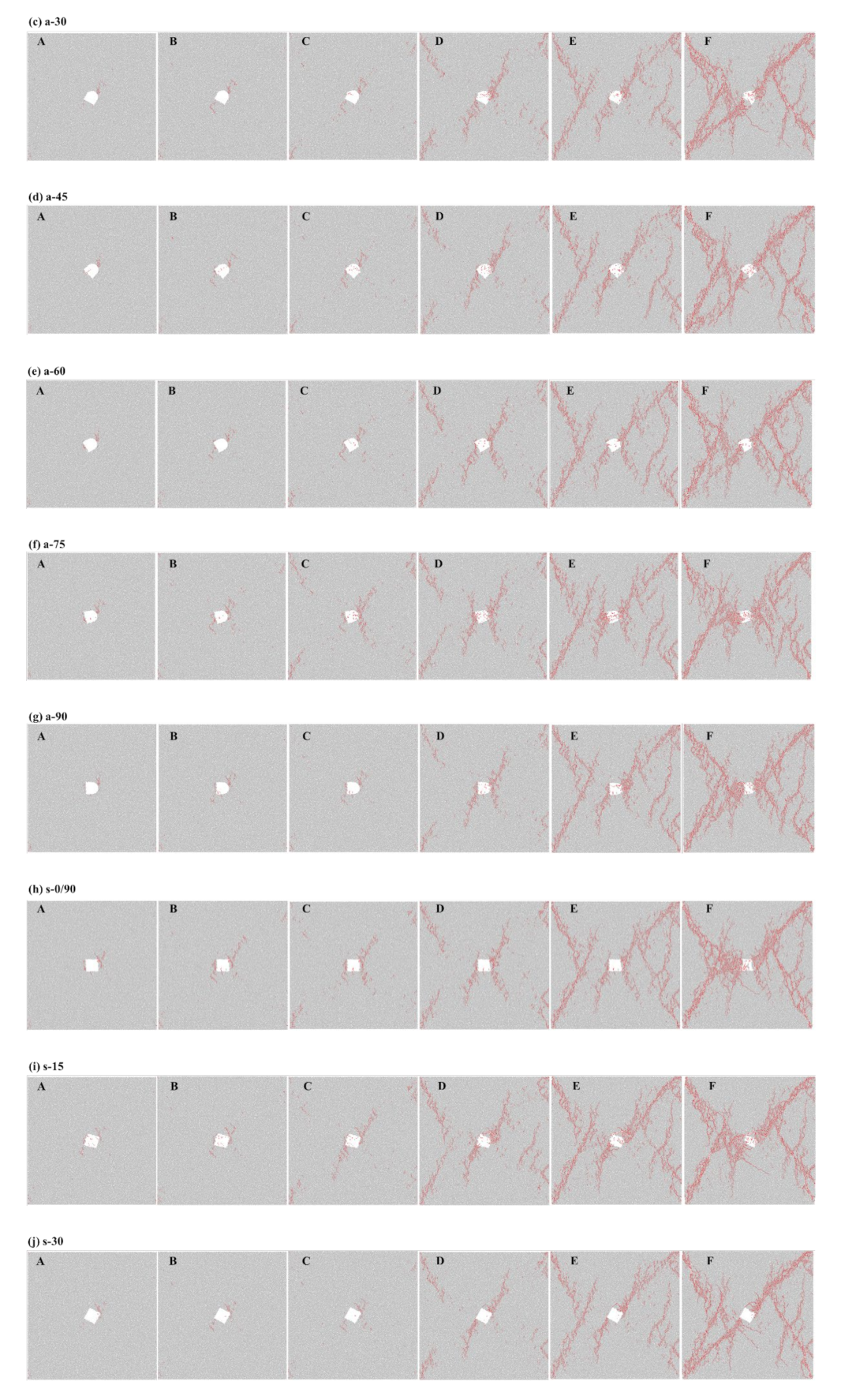
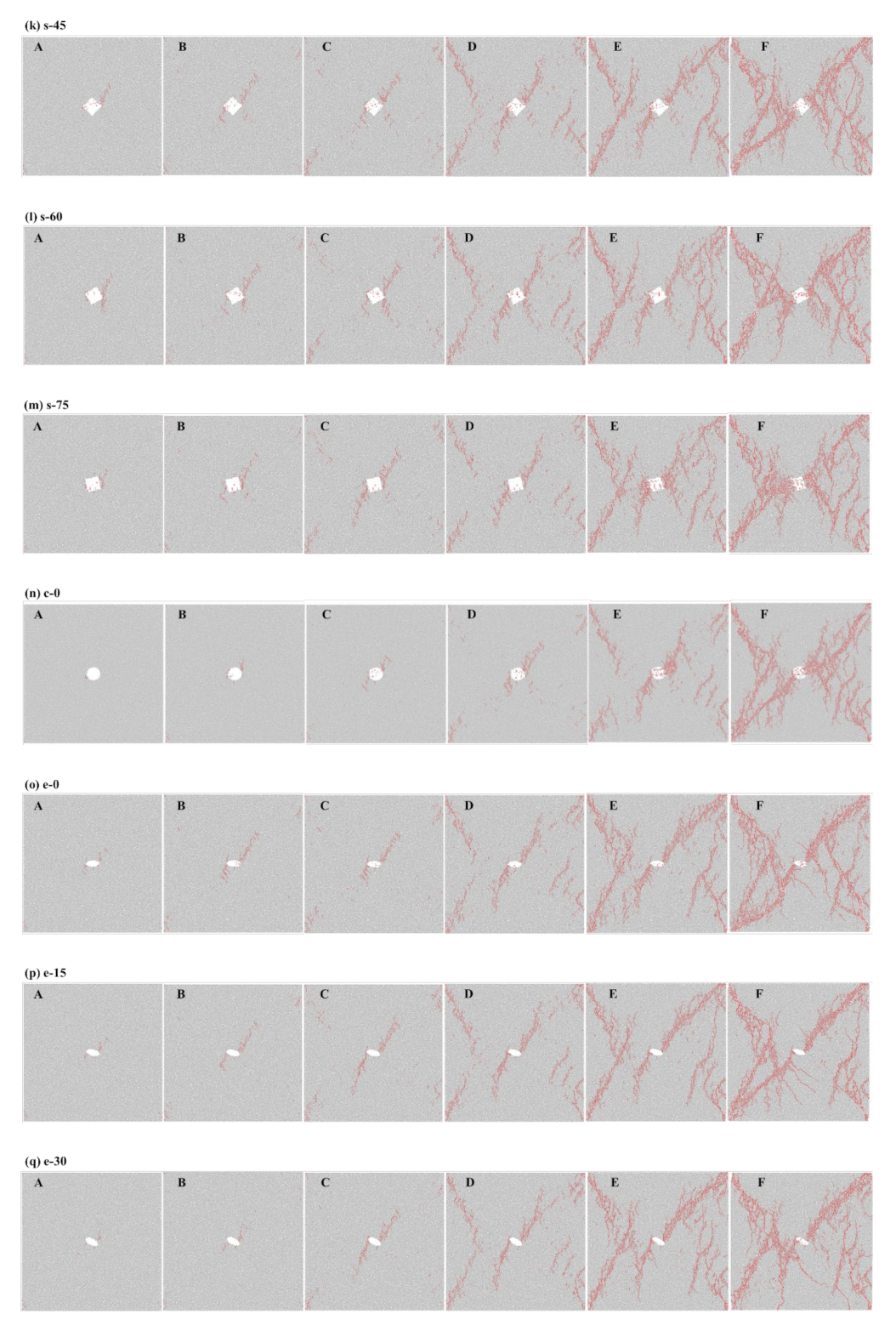

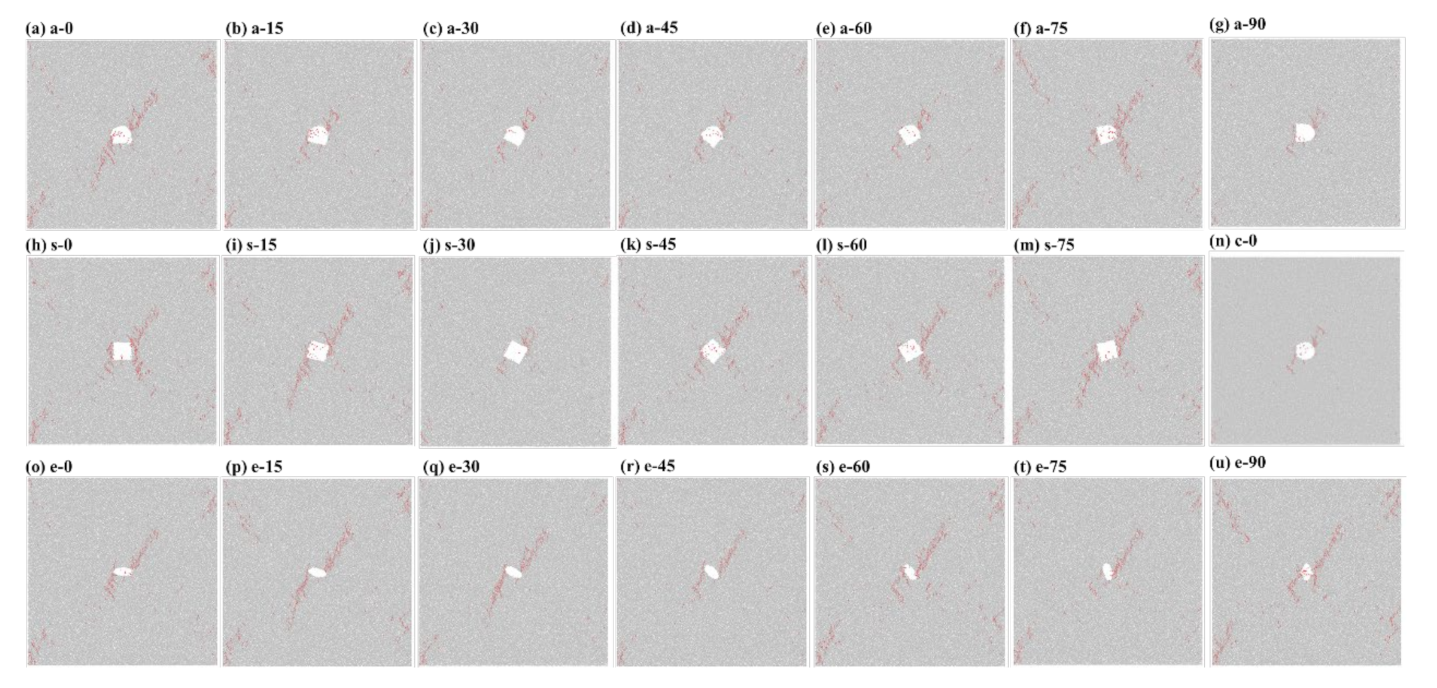
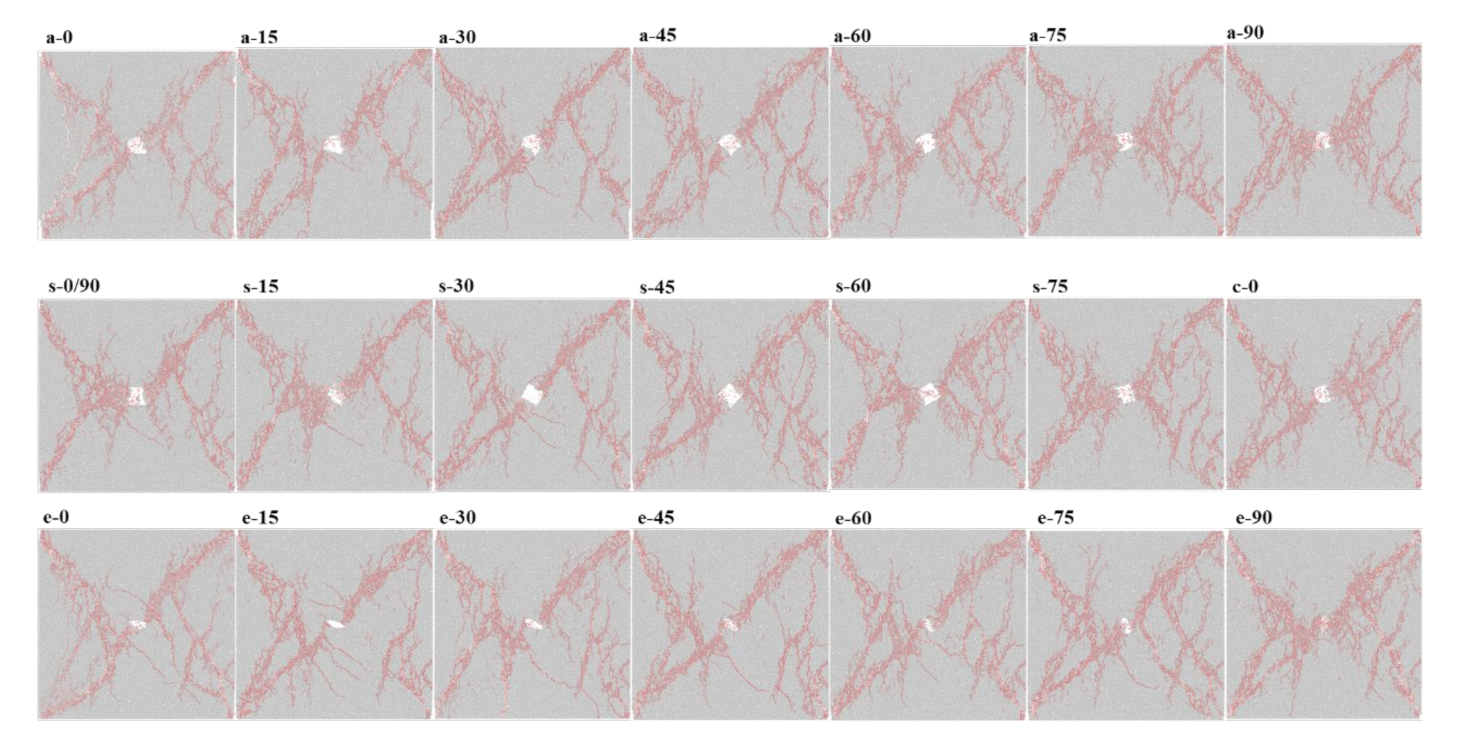
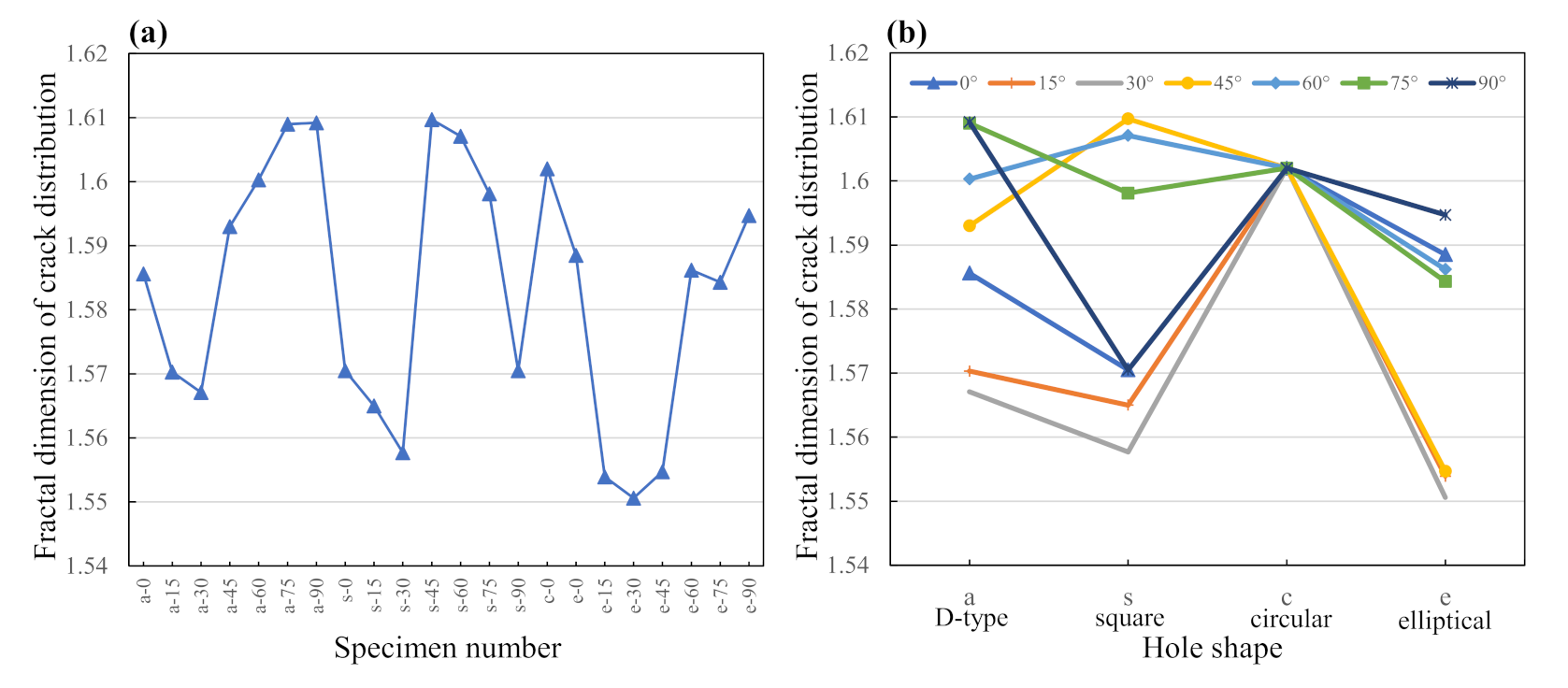
| Microscopic Parameters | Values |
|---|---|
| Minimum particle radius, Rmin (mm) | 0.25 |
| Maximum particle radius, Rmax (mm) | 0.415 |
| Particle size ratio, Rmax/Rmin | 1.66 |
| Bulk density, ρ (kg/m3) | 2604 |
| Particle contact modulus, Ec (GPa) | 20 |
| Ratio of normal to shear stiffness of the particle, kn/ks | 1.7 |
| Parallel-bond modulus, c (GPa) | 20 |
| ns | 1.7 |
| Particle friction coefficient, μ | 0.5 |
| Parallel-bond normal strength, mean σn (MPa) | 85 |
| Parallel-bond normal strength, standard deviation, σsd (MPa) | 8 |
| Parallel-bond shear strength, mean τn (MPa) | 67 |
| Parallel-bond shear strength, standard deviation τsd (MPa) | 6 |
| Parameter | Experimental Tests | Numerical Tests | Errors (%) |
|---|---|---|---|
| Density (kg/m3) | 2604 | 2604 | - |
| Young’s modulus (GPa) | 33.14 | 32.92 | 0.66 |
| Poisson’s ratio | 0.21 | 0.21 | - |
| Uniaxial compressive strength | 126.59 | 126.68 | 0.07 |
| Specimen | σucs (MPa) | σbcs (MPa) | σ(ucs + bcs)/2 (MPa) | σbu (MPa) | σls (MPa) |
|---|---|---|---|---|---|
| a-0 | 130.50 | 182.97 | 156.74 | 165.85 | 14.50 |
| a-15 | 129.08 | 183.73 | 156.41 | 166.12 | 14.94 |
| a-30 | 128.95 | 181.25 | 155.10 | 165.48 | 14.64 |
| a-45 | 131.90 | 182.53 | 157.22 | 166.02 | 15.11 |
| a-60 | 135.10 | 184.91 | 160.01 | 168.28 | 15.25 |
| a-75 | 134.43 | 184.46 | 159.45 | 166.07 | 13.83 |
| a-90 | 128.86 | 184.28 | 156.57 | 163.39 | 16.59 |
| s-0 | 127.98 | 180.00 | 153.99 | 162.63 | 14.76 |
| s-15 | 126.01 | 184.82 | 155.42 | 161.95 | 13.87 |
| s-30 | 128.54 | 185.12 | 156.83 | 164.90 | 16.19 |
| s-45 | 130.25 | 183.07 | 156.66 | 164.80 | 14.47 |
| s-60 | 130.03 | 190.17 | 160.10 | 168.23 | 14.41 |
| s-75 | 126.57 | 185.00 | 155.79 | 162.81 | 15.81 |
| s-90 | 127.98 | 180.00 | 153.99 | 162.63 | 14.76 |
| c-0 | 135.05 | 187.41 | 161.23 | 169.87 | 15.71 |
| e-0 | 131.07 | 198.32 | 164.70 | 171.54 | 15.13 |
| e-15 | 142.17 | 189.59 | 165.88 | 171.41 | 14.02 |
| e-30 | 128.85 | 189.93 | 159.39 | 168.52 | 16.29 |
| e-45 | 132.78 | 190.79 | 161.79 | 169.89 | 15.82 |
| e-60 | 137.41 | 196.86 | 167.14 | 175.41 | 13.47 |
| e-75 | 136.04 | 201.52 | 168.78 | 178.60 | 14.78 |
| e-90 | 145.61 | 203.18 | 174.40 | 182.17 | 14.55 |
Publisher’s Note: MDPI stays neutral with regard to jurisdictional claims in published maps and institutional affiliations. |
© 2022 by the authors. Licensee MDPI, Basel, Switzerland. This article is an open access article distributed under the terms and conditions of the Creative Commons Attribution (CC BY) license (https://creativecommons.org/licenses/by/4.0/).
Share and Cite
Zhou, Z.; Pi, Z.; Jing, Y.; Wang, S. Responses of Pre-Holed Granite under Coupled Biaxial Loading and Unloading Stress Condition. Minerals 2022, 12, 372. https://doi.org/10.3390/min12030372
Zhou Z, Pi Z, Jing Y, Wang S. Responses of Pre-Holed Granite under Coupled Biaxial Loading and Unloading Stress Condition. Minerals. 2022; 12(3):372. https://doi.org/10.3390/min12030372
Chicago/Turabian StyleZhou, Zilong, Zizi Pi, Yue Jing, and Shaofeng Wang. 2022. "Responses of Pre-Holed Granite under Coupled Biaxial Loading and Unloading Stress Condition" Minerals 12, no. 3: 372. https://doi.org/10.3390/min12030372






